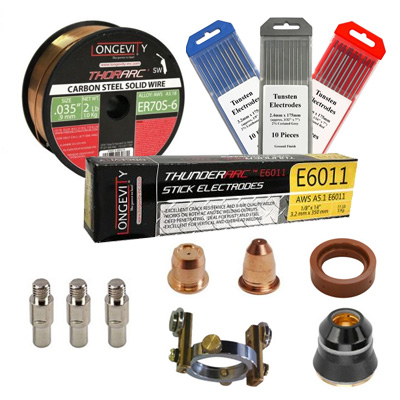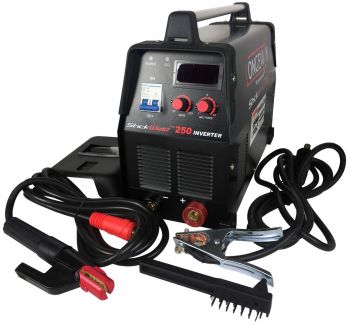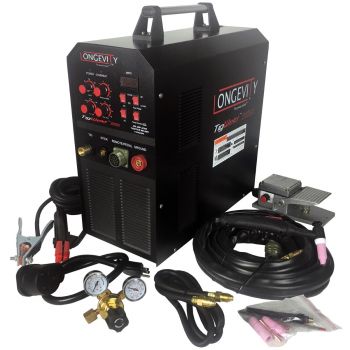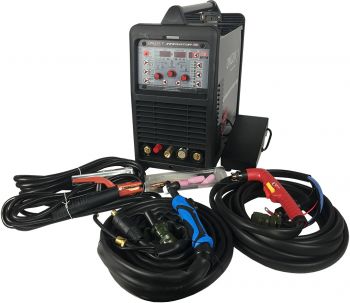Welding two pieces of metal together forms a permanent bond in which the metals are heated to a melting point, mixed together and then cooled, creating a single object. This type of bond is stronger than other bonds, such as soldering, which can be reversed.
There are four basic types of welding: MIG, TIG, Flux-Cored, and STICK. The process and welding techniques to be used depending on the application, the types of metal to be welded, and the skill and experience of the welder.
New welders just learning how to weld should start with Metal Inert Gas (MIG) welding, also known as Gas Metal Arc Welding (GMAW). MIG is a type of electric arc welding, which relies on creating an electrical circuit that runs through the objects to be welded together and a welding wire, which acts as an electrode.
When the welding wire touches the metal object, the circuit is completed. The wire is then pulled back a short distance, causing an electric arc that heats up to thousands of degrees Fahrenheit, melting the wire and partially melting the two pieces of metal. This creates a melt pool where all three metals merge to become one as it cools and solidifies, leaving a bead along the welded seam.
As the welding action continues down the seam, the wire melts off and more wire is fed continuously from the tip of the welding gun. At the same time, a gas is diffused from the gun, spreading around the arc to shield the welded area from contaminants in the air, such as oxygen and nitrogen.
Tungsten Inert Gas (TIG) welding requires more skill and takes longer than MIG welding, but it offers more precision. TIG, also known as gas Tungsten Arc Welding (GTAW), can be used to weld aluminum and alloys, such as 4130 chrom-moly.
TIG welding is similar to MIG, but instead of a consumable wire, the electrode used is a tungsten metal rod inside the welding gun. The welder holds the gun in one hand while feeding a filler rod in the other hand. As the arc creates a melted puddle from the two work pieces, the heat of the melt puddle melts the filler rod, so that all three mix together in the puddle. Like MIG welding, TIG welding guns disperse a shielding gas to protect the new weld.
A TIG welding machine also includes a foot pedal to adjust the current running through the electrical circuit created between the metal objects and the tungsten electrode. This can be used to slowly increase or decrease the heat applied to the metal, which can help prevent brittleness caused by thermal shock.
A third type of welding, called flux-cored arc welding (FCAW), uses a continuously fed electrode tube in place of the wire used for MIG welding. The tube is metal on the outside, with a flux agent in the core. As the flux melts during welding action, it creates a liquid slag and gas that shields the weld from contaminants. This provides better protection for the weld than the shield gas used in MIG welding, especially where strong breezes might disperse the gas, but it also results in more spatter which must be cleaned up afterwards.
Otherwise known as Shielded Metal Arc Welding (SMAW), stick welding is a two-handed method, like TIG. STICK welding uses a metal filler rod, or stick, coated with flux. As the stick material melts in the heat, the flux coating also melts, creating both a gas and a liquid slag, which act to shield the weld from oxidation. As with FCAW, shield gas does not have to be dispensed during the welding process but the leftover slag leaves a mess requiring cleanup using a sander or solvents.
Materials needed for welding include consumables, such as MIG wire and flux-cored wire in various diameters and materials, welding tips, electrode sticks or tubes, flux, and TIG or gas brazing rods.
Other useful equipment includes magnets and clamps to hold metal objects in place during welding, adjustable welding tables and workstands, and fiberglass welding blankets to prevent the spread of sparks. Weld-on tabs in a variety of sizes and shapes are used to create flanges, holes, handles, and other mechanical parts when welded to a pipe or other metal object.
MIG / TIG / STICK WELDERS
Beginner's Guide to Welding
-
-
-
- INNOVATOR 255i TIG/STICK Welder / Plasma Cutter 250 Amp AC/DC Pulsed TIG/STICK Welder / 40 Amp Plasma Cutter$1,999.99










